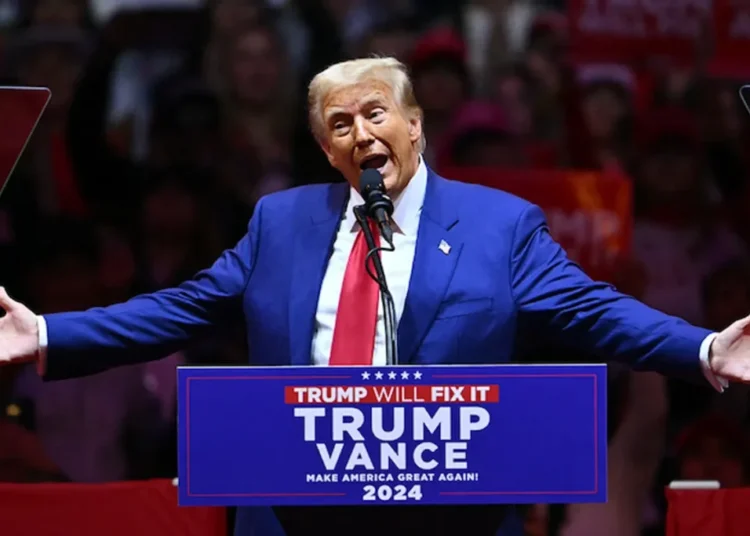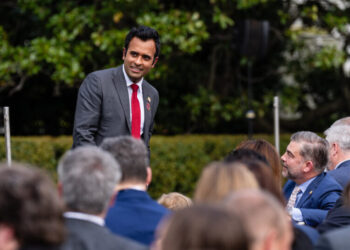Eli Lilly, the maker of hugely popular weight loss drugs, has reached $1 trillion in value, becoming the first publicly traded company in health care to hit the milestone.
Lilly’s stock has surged in large part because of the company’s success in seizing the biggest potential market in the history of the drug industry: the class of weight loss medicines known as GLP-1s.
The company’s injection, sold as Zepbound and Mounjaro, is on track to be the top-selling drug in the world this year.
Only a handful of publicly traded companies, mostly in technology, have reached the $1 trillion benchmark. Nvidia, the A.I. chip maker, recently became the first publicly traded company worth $5 trillion. The second-most valuable health care company, Johnson & Johnson, is worth about half a trillion dollars.
Under the watch of Dave Ricks, who became chief executive in 2017, Lilly has added more than $900 billion to its market value.
Along the way, the once-sleepy company, which is 150 years old and based in Indianapolis, has become ubiquitous. Zepbound is everywhere and Caitlin Clark wears Lilly’s logo on her Indiana Fever jersey. Mr. Ricks has been touring the podcast circuit and was briefly spoofed this month in a Saturday Night Live cold open.
Mr. Ricks has cultivated a relationship with President Trump, dining with him and others at Mar-a-Lago.
And this month, in the Oval Office, Mr. Trump called Mr. Ricks “one of the hottest people in the world in business.” The two announced a pricing deal, along with other drug company executives and U.S. health officials.
Under the deal, people will be able to use their own money to pay $449 a month for higher doses of Zepbound, a $50 discount off the current price. The deal will expand coverage for certain people on Medicare and Medicaid and lower the government’s costs for Zepbound, for those eligible, to $245 a month. The agreement has helped fuel a surge in Lilly’s stock price.
Over the past year and a half, Lilly’s main competitor in the weight loss drug market, Novo Nordisk, has faltered. It has been steadily losing market share for its weight loss drug, sold as Ozempic and Wegovy. Investors are unconvinced that Novo Nordisk has a future pipeline of lucrative drugs.
Lilly, by contrast, has been developing a daily pill for obesity as well as another promising weight loss injection. These and other products expected to arrive in the next few years are poised to keep revenues flowing.
Over the decades, Lilly has become known for popular and essential products like Prozac and the polio vaccine. Today, Lilly also sells other well-known drugs like Verzenio, for breast cancer; Kisunla, for Alzheimer’s disease; and, most controversially, insulin.
An outcry over insulin prices
For years, Lilly was the target of a sustained pressure campaign to lower insulin prices, waged by people with diabetes who said the company’s financial success had come at the expense of patients who could not afford insulin. Without insulin, people with diabetes can die or face serious health consequences, including amputation and kidney failure.
Over two decades, Lilly raised the sticker price of Humalog, its widely used insulin, by more than 1,000 percent. It last increased the sticker price in 2017 to $275 a vial, shortly after Mr. Ricks became chief executive. Patients often need several vials a month.
About 550 U.S. states, cities, counties, unions and other payers have sued Lilly, along with other insulin makers and big pharmacy benefit managers, claiming that they inflated insulin prices.
Mr. Ricks has repeatedly defended his company’s decisions on insulin. Instead, he has blamed pharmacy benefit managers for driving up sticker prices and exposing patients to huge costs.
“The person who walked in the pharmacy with no insurance, they had to pay that. That’s outrageous,” Mr. Ricks said on a podcast this month. “That should not exist.”
In 2023, bowing to the public outcry, Lilly slashed the sticker prices of Humalog and other older products and made it easier for many privately insured patients to take advantage of an existing policy that caps their out-of-pocket costs for insulin at $35 a month. A federal law applied the same cap in Medicare.
Last year, the average monthly out-of-pocket cost for Lilly insulin was $14.86, according to Niki Biro, a spokeswoman for Lilly.
But doctors and advocates say that despite the changes, insulin remains unaffordable for many patients.
In a small study published this month, researchers surveyed patients with diabetes who rely on insulin and receive care at Yale Diabetes Center in New Haven, Conn. Despite the pricing changes of the last few years, a quarter of the patients reported rationing their insulin in 2024, the same percentage as those who responded to a similar survey conducted in 2017.
Dr. Kasia Lipska, a Yale endocrinologist and the study’s senior author, said the patients still struggling with costs appear to include those with the most limited incomes, those who take multiple insulin products and those who may not know how to obtain their product at the lower prices.
“People get lost navigating this complex web of different Band-Aids that have been placed on the system,” she said.
In Rockville, Ind., just over an hour’s drive west of Lilly’s headquarters, Molly King, 33, said she was still paying about $200 a month for two vials of Humalog that help keep her alive. Her health insurance is provided by her employer, a public school district, where she works as a special-education teacher.
It was not clear why Ms. King is not benefiting from the promised cap on out-of-pocket costs. Ms. Biro, the company spokeswoman, said no one should pay more than $35 a month for a monthly supply of Lilly insulin and that the company offers a hotline to help.
In 2017, when Ms. King was on an Obamacare plan, she was paying a total of $400 a month out of pocket for Humalog and a second insulin product she takes that is made by Sanofi. Unable to afford the cost, she rationed her insulin and wound up in the intensive care unit with diabetic ketoacidosis, a life-threatening condition that can occur when the body doesn’t have enough insulin.
Ms. King now helps lead the Indiana chapter of T1International, an advocacy group for people with diabetes. Watching Lilly’s stock price soar, Ms. King said, has been “infuriating.”
An old fortune and a new gold mine
The company’s origins date to 1876, when a 37-year-old veteran of the Union Army named Eli Lilly opened a small drugstore in Indianapolis. Early products included pills coated in gelatin and a plant-based syphilis treatment. Within a decade, the company incorporated, issued stock and hired a chemist.
Today, the company has 50,000 employees worldwide, about a quarter of whom are in Indianapolis. Lilly has said it will spend $14 billion this year on research and development.
Mr. Lilly’s heirs have spent decades distributing the fortune he seeded. In the 1930s, the family set up the Lilly Endowment with gifts of company stock. Today, the foundation gives away money to nonprofits in Indiana and beyond, including to seminaries, churches, museums and national parks.
The Lilly Endowment, its stock holdings flush from the weight loss drug craze, reported that its assets surged last year to nearly $80 billion — more than those of the Gates Foundation.
At the start of 2017, the company was worth $81 billion — far shy of industry peers like Johnson & Johnson — when Mr. Ricks became chief executive after spending two decades working his way up the ranks.
No one knew it at the time, but Lilly’s scientists had already stumbled upon a gold mine. In 2015, the company began seeking patents for a drug it had discovered in-house that looked promising for treating diabetes. In 2022, Lilly started selling it as Mounjaro as a treatment for diabetes and then, a year and a half later, won approval for it to tackle obesity as Zepbound.
During the coronavirus pandemic, Lilly developed and sold a treatment aimed at keeping high-risk patients with Covid out of the hospital, but it stayed out of the vaccine race. The two Covid vaccine makers best known to most Americans, Pfizer and Moderna, have both been mired in slumps in the post-Covid years.
Pharmaceuticals is a notoriously cyclical business. Companies buoyed by once-in-a-generation product lines flounder after their blockbuster drugs lose patent protection.
“You literally have to reinvent yourself every 10 to 12 years,” said John LaMattina, who was once the top scientist at Pfizer and is now a senior partner at PureTech Health, a firm that creates biotech start-ups.
But in his recent podcast interview, Mr. Ricks said the company was trying to do something different with the weight loss drugs. Patients, and the Trump administration, have embraced the direct-sales website that Lilly introduced last year, which allows patients to use their own money to buy the medications.
There is potential, he said, to “create much more of a self-pay branded business that has staying power beyond the patent cycle.”
By about March of next year, Lilly is expected to win fast-tracked regulatory approval for orforglipron, the daily weight loss pill it has been developing. Anticipation of the new pill appears high, even though the company’s data shows it to be a bit less effective than the injections.
For patients who pay using their own money, Lilly plans to charge $149 a month for a starting dose of the pill and $399 for higher doses.
The company is developing another weight loss injection, retatrutide, that is being closely watched because it appeared to generate more weight loss than the drugs available now when it was tested in a mid-stage clinical trial. Results are expected in the coming months from late-stage studies of retatrutide.
Joe Rennison contributed reporting.
Rebecca Robbins is a Times reporter covering the pharmaceutical industry. She has been reporting on health and medicine since 2015.
The post Eli Lilly Reaches $1 Trillion in Value, Buoyed by Demand for Its Weight Loss Drugs appeared first on New York Times.




